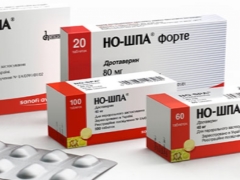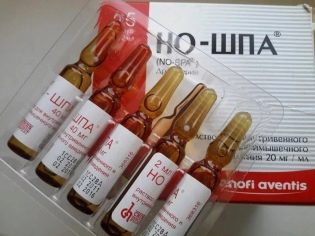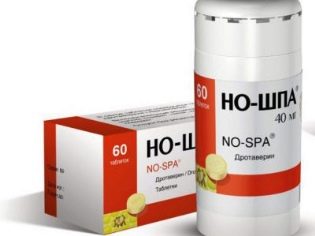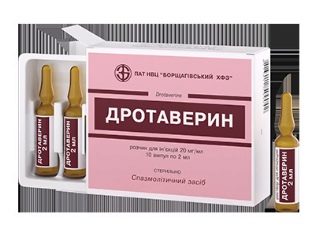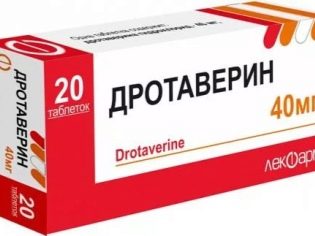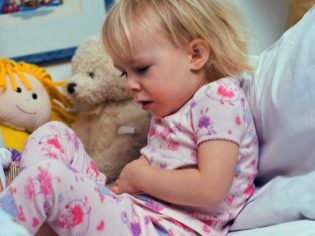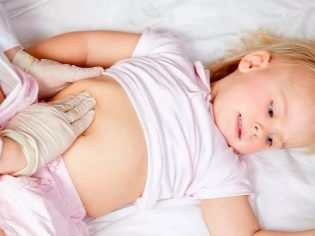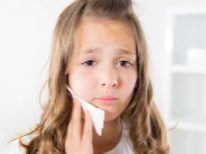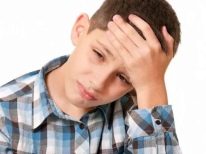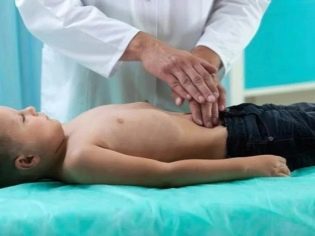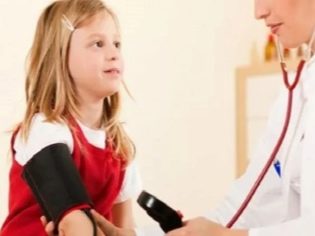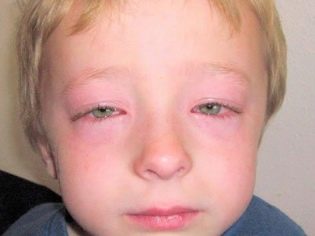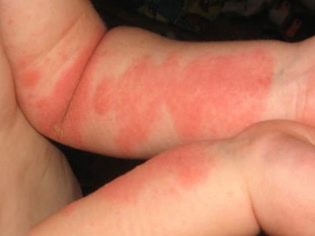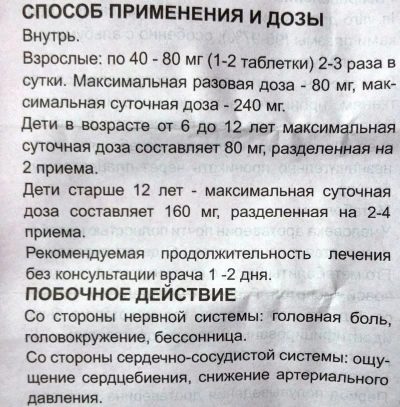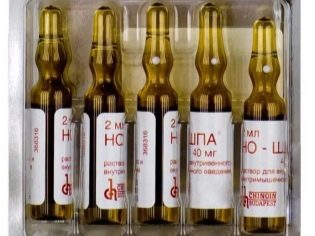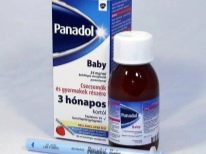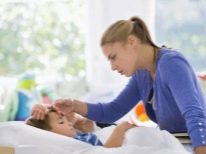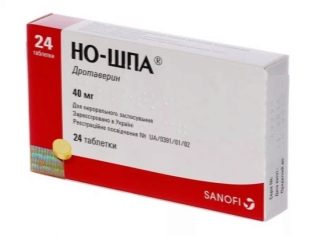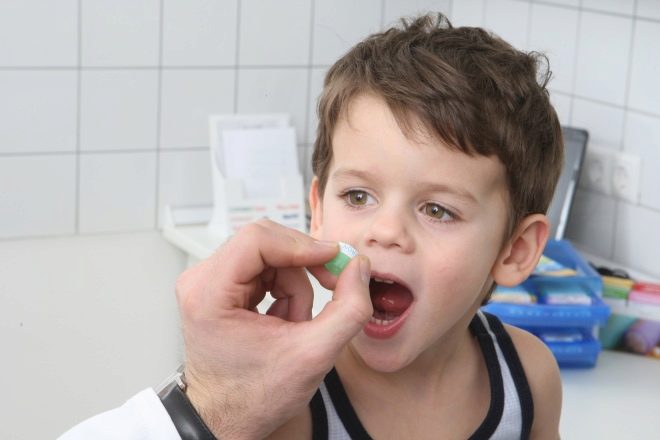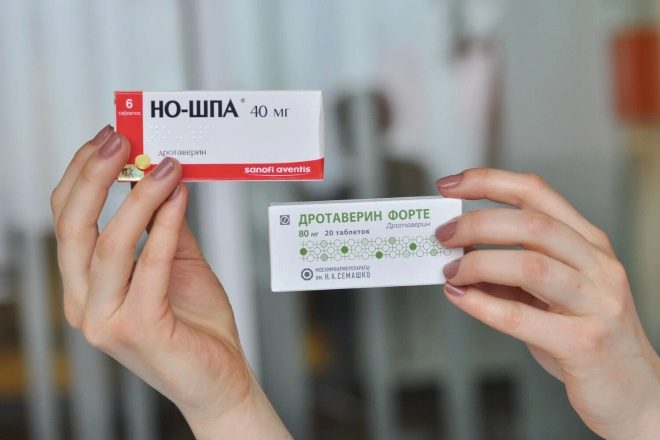No-shpa for children
Pain is a common problem in both adults and children. Sometimes they are caused by smooth muscle spasms and then antispasmodics are used for treatment. One of the most famous drugs of this group can be called No-shpu. When is this medicine prescribed for children and at what dose?
Release form
No-shpa is presented in pharmacies in two forms:
- Pills, which have a greenish yellow or yellow-orange color, a convex round shape and on one side has a “spa” stamping. Such tablets are packaged in blisters of 6, 10, 12 or 24 pieces, so from 6 to 30 tablets are sold in one box. In addition, the drug is released in plastic bottles containing 60 or 100 tablets.
- Ampoules containing a clear yellow-green solution that is intended to be injected into a muscle or for intravenous injections. One such ampoule of dark glass contains 2 ml of the medicine, and in one pack there are 5 or 25 ampoules.
In addition, the drug is produced under the name No-spa forte. Such tablets differ in shape (they are oblong), engraved on one side (“NOSPA” is written on them) and the amount of the active ingredient (it is contained in a dose of 80 mg per 1 tablet). Otherwise, this medicine is identical to No-shpa pills, both in composition and in indications and precautions.
Composition
The main component of both forms of no-shpy is Drotaverine Hydrochloride. One tablet contains this substance in a dose of 40 mg. The same amount of Drotaverinum is in one ampoule, that is, the amount of such an ingredient in 1 ml is 20 mg.
Additionally, lactose monohydrate, corn starch, talc, povidone and magnesium stearate are present in the solid form of the drug. Solution No-shpy for injection in addition to drotaverin includes sterile water, 96% alcohol and sodium disulfite.
Operating principle
The main ingredient of No-shpy has a pronounced antispasmodic effect on smooth muscle. The result of this effect is the relaxation of smooth muscles that are in the walls of the stomach and intestines., as well as in the urinary tract and biliary tract. Due to such relaxation, the pain syndrome caused by spasm is eliminated.
The therapeutic effect is associated with the inhibition of a certain enzyme responsible for the reduction of smooth muscles in these organs.
In addition, No-shpy has some effect on the vessels, due to which they expand, which has a positive effect on the blood supply to the tissues.
Ingested tablets are rapidly absorbed and begin to act after about 30 minutes. The effect after the introduction of the solution intramuscularly appears after 3-5 minutes. The maximum amount of drotaverine is determined in the blood 45-60 minutes after administration. Combined with plasma proteins, the drug is transferred to smooth muscle cells. After complete metabolic transformation in the liver, the drug leaves the body for 72 hours mainly with urine and bile.
Indications
No-shpu is prescribed to eliminate spasms in case of such pathologies:
- Cholecystitis.
- Cholangitis
- Pericholecystitis.
- Cystitis.
- Gastritis.
- Biliary colic.
- Irritable bowel syndrome.
- Pyelitis.
- Enteritis.
- Spastic colitis.
- Intestinal colic.
- Gastrointestinal ulcer.
In addition, the remedy is prescribed for headaches, vomiting, dry cough (for example, with laryngitis, the medication is given before bedtime), as well as for toothache.
In childhood, No-spa is very popular with spasm of blood vessels and at high temperatures ("white" fever).
This condition, manifested by chills, pallor of the skin and cold to the touch of the extremities, may be complicated by febrile convulsions, therefore, a combination of several drugs — an antipyretic, an antispasmodic, and an antihistamine drug is prescribed as emergency care. And among all the antispasmodic drugs, the choice often falls precisely on No-shpu, as the most effective and safe drug.
From what age is appointed?
No-shpa tablets, according to the instructions for this form of medicine, allowed for the treatment of children older than 6 years. In the annotation to the ampoules it is noted that the drug is contraindicated in children due to the lack of a sufficient base of clinical studies confirming the safety of this drug in childhood. Nevertheless, in practice, doctors prescribe injections and tablets for patients older than one year.
However, if an infant is required to undergo treatment, he is prescribed other medications, for example, Papaverine, which is allowed from 6 months of age.
Contraindications
But the silo is not used if the child:
- A serious pathology of the kidney, impaired excretory function.
- Diagnosed with severe heart failure.
- There is intolerance to any of the components of the tablets or solution.
- Revealed a severe violation of the liver.
The solid form is also not prescribed for inherited pathologies of carbohydrate absorption. For adults, the drug is not recommended for breastfeeding. If a patient has low blood pressure, give No-shpu with caution, because there is a risk of collapse.
Do not use tablets with severe pain in the abdomen, because they can be a sign of a serious surgical pathology (for example, appendicitis).
In such a situation, you must first show the small patient to the doctor to prevent the development of life-threatening complications.
Side effects
In rare cases, the treatment of No-Spa may cause:
- Nausea
- Allergic rash.
- Dizziness.
- Palpitations.
- Constipation.
- Quincke swelling.
- Headache.
- Lowering blood pressure.
- Urticaria
- Insomnia.
- Itchy skin.
According to studies, such negative symptoms develop in less than 0.1% of patients.
Instructions for use and dosage
But the silos in the tablets are swallowed and washed down with a small amount of water. The dosage and mode of administration is determined by the doctor based on the age of the small patient:
- Children 6-12 years old the medication is given one tablet once a day, and if necessary, you can drink the medicine a second time. The maximum daily dose for patients of this age (for example, for a child of 7 or 8 years old) is 80 mg.
- For a child over 12 years old a single dose is also often 1 tablet, but can be increased to two tablets at once. The maximum per day a patient of this age can be given 160 mg of drotaverine, so you can take the medicine 1 to 4 times a day if the child is given 1 tablet per dose or 1-2 times if the teenager swallows 2 tablets at once.
- For children 1-6 years dosage and frequency of pills is determined by the attending physician.
The duration of the use of shpy should also be determined by the doctor. Without a pediatrician consultation, you can take pills for 1-2 days, and if they are ineffective, you can immediately contact a specialist.
Consultation with a doctor is also needed for the injection of No-shpy in solution, since the doctor must be convinced of the need for injections and determine both the desired dose and the route of administration.
For example, if No-shpa is used as part of a lytic mixture, then for one injection take 1 ml of medication for a child over 6 years old and 0.5-1 ml of solution for a patient under 6 years old. The proportions of other medicines are also selected according to the age of the child.
Overdose
If you exceed the dose of no-shpy, it is dangerous for the heart to work, since an excess of drotaverine can disrupt the rhythm of the heartbeats and worsen conductivity. In severe cases, the drug provokes cardiac arrest. For this reason, an overdose child should immediately call an ambulance because such a patient requires medical supervision.
Interaction with other drugs
If to apply No-shpu together with other antispasmodics, then the therapeutic effect of such drugs will increase. The drug is often combined with antipyretic (Analgin, Paracetamol, Ibuklin, Ibuprofen) and antihistamine drugs (Suprastin, Diphenhydramine).
In such a combination, for example, with Nurofen, No-shpa helps to get rid of a fever dangerous for the child.
Terms of sale
No-silos in tablets can be freely purchased at most pharmacies, as this is a non-prescription drug. The average price of 6 tablets is 55-65 rubles, 24 tablets - about 120 rubles, and for a bottle with 100 tablets you need to pay from 200 to 240 rubles. To purchase an injection solution, you must first obtain a prescription from a doctor. On average, 5 ampoules of No-shpy cost 100 rubles.
Storage conditions
Storage as a tablet No-shpy, and the solution in ampoules should be in a dry place at temperatures below +25 degrees. The shelf life of the solid form of the drug is 3 years or 5 years, injectable - 5 years.
Reviews
On the application of No-shpy in children can be found mostly good reviews. In them, mothers confirm the effectiveness of the medicine for headaches, renal colic and bowel spasms. According to parents, little patients tolerate No-shpu mostly well, and allergies or other side effects are very rare. As for the shortcomings, the most expensive of them include the high cost of the drug.
Analogs
The drug, which is often bought instead of No-shpy, is Drotaverinum. It is cheaper, however, it is not so well cleaned of impurities and its production is not as closely controlled as No-shpa, therefore during treatment Drotaverine side reactions are more often observed, and the effect of the use is weaker.
In addition, other drugs based on drotaverine, such as Spazmonet, Smazmol or Dverin. They are available in both tablet and injectable form, and are prescribed for the same diseases for which No-shpa is indicated. If a child has flatulence, vomiting, belching, nausea, and other negative symptoms from the gastrointestinal tract, No-silo is often replaced with domperidone, for example, suspension Motilium or pills Motilak.
They help well if the small patient has rotavirus, esophageal reflux, functional digestive disorders, as well as many other problems.
For information on how to properly take this drug, see the next video.
